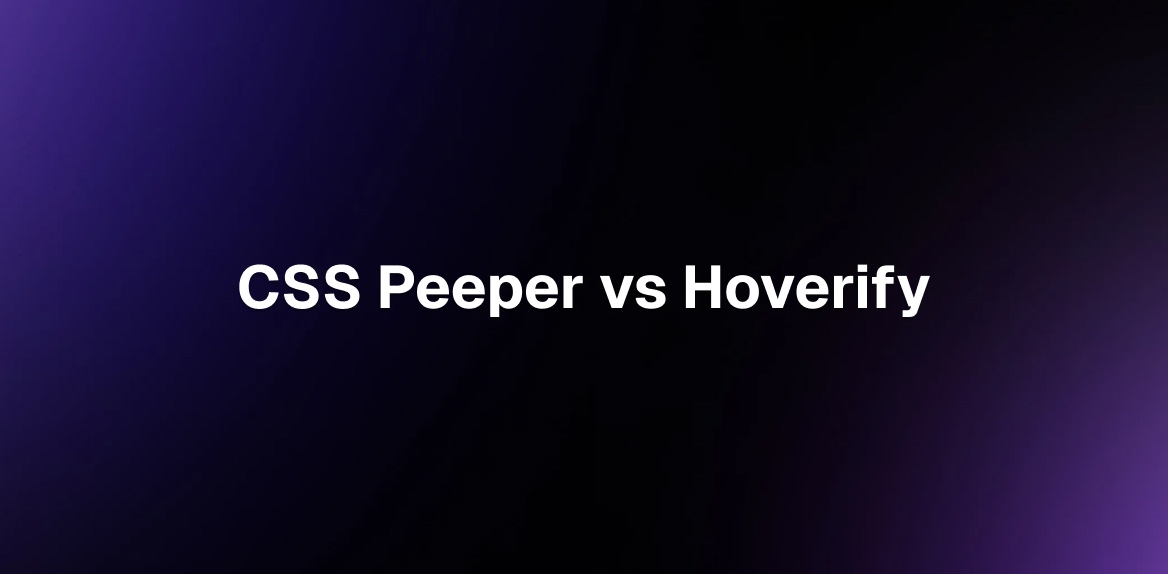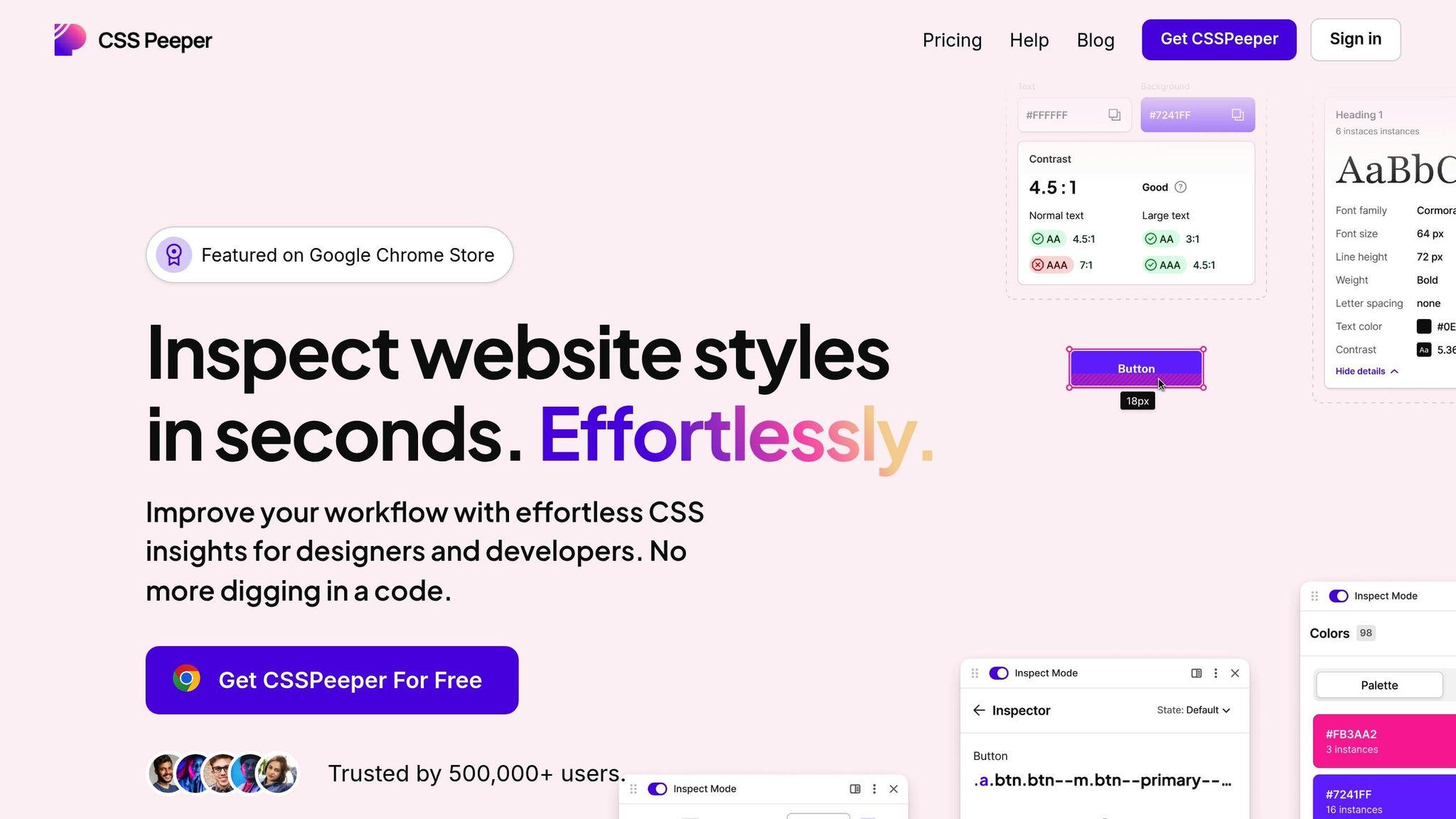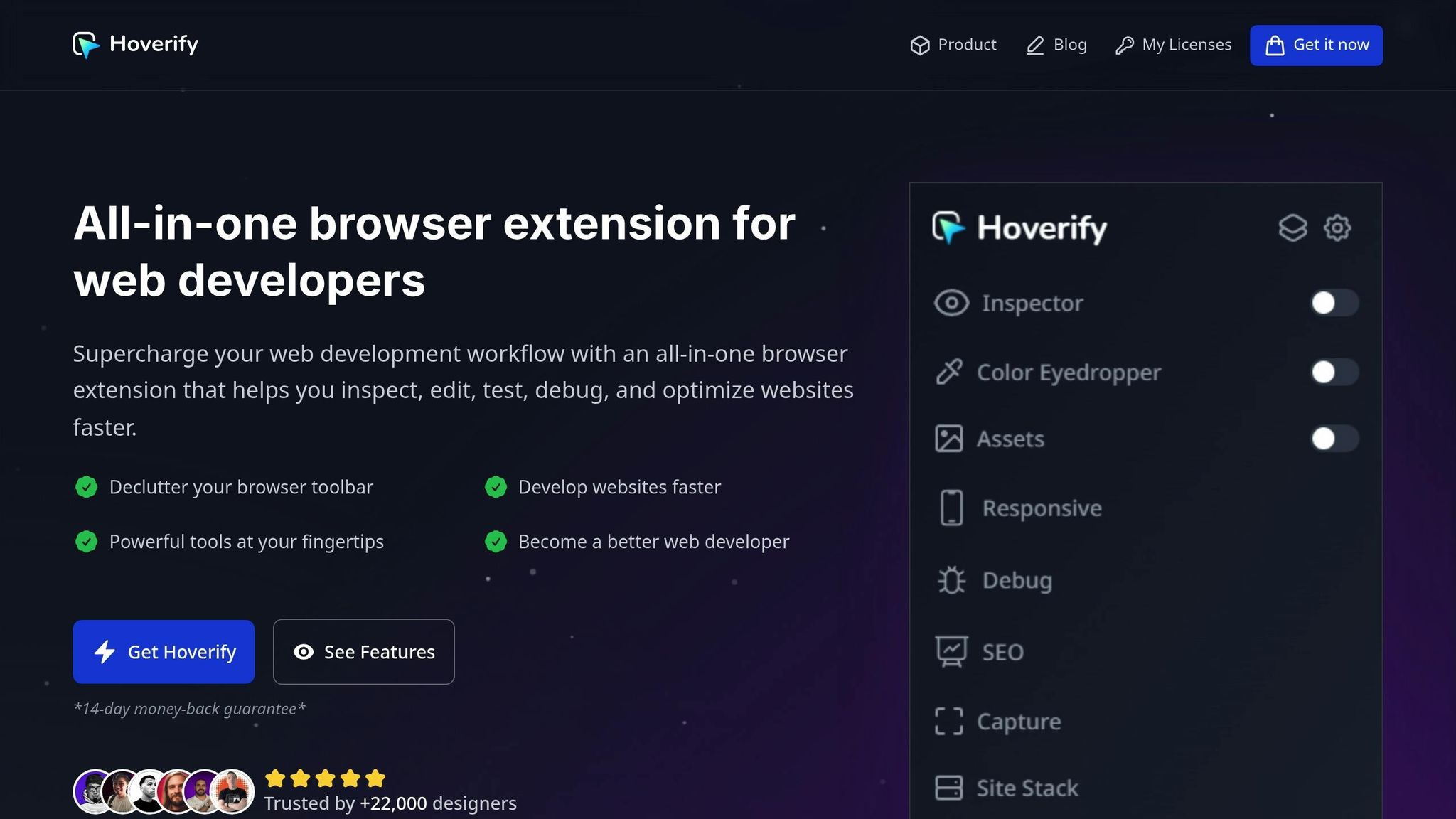
Looking for a tool to simplify CSS inspection? Here’s the quick takeaway: CSS Peeper is great for extracting CSS details and design assets quickly, while Hoverify offers a full set of tools for inspecting, editing, debugging, capturing, and testing - all in one browser extension.
CSS Peeper:
- Focuses on CSS inspection and asset extraction.
- Ideal for designers needing a simple way to collect fonts, colors, and spacing info.
- Perfect for tasks like design handoffs and building style guides.
Hoverify:
- Combines CSS inspection with real-time editing, responsive testing, and debugging.
- Includes advanced tools like tech stack analysis, SEO reviews, and bulk asset downloads.
- Suited for developers who need a complete solution.
Quick Comparison
| Feature | CSS Peeper | Hoverify |
|---|---|---|
| CSS Inspection | Basic hover details | Hover and click-to-edit styles |
| Real-time Editing | Not available | Edit CSS, HTML, and media queries |
| Responsive Testing | Not available | Multi-device testing with frames |
| Asset Extraction | Images only | Bulk download of images, videos |
| SEO Analysis | Not available | Analyze meta tags, headers, links |
| Tech Stack Info | Not available | Detect hosting, plugins, and more |
Bottom Line: Choose CSS Peeper for quick, design-focused tasks. Opt for Hoverify if you need a powerful, all-in-one development tool.
CSS Peeper Overview

CSS Peeper is a browser extension designed to make inspecting website CSS straightforward and user-friendly. It simplifies the often tedious process of analyzing styles, making it a handy tool for web developers looking to streamline their workflows. Here’s a closer look at its features, how to use it, and some of its limitations.
Main Features of CSS Peeper
CSS Peeper allows users to extract and view CSS details in a clean, easy-to-read format. Instead of digging through code, developers can quickly access a summary of a webpage’s styles, saving time and effort.
How to Use CSS Peeper
Using CSS Peeper is simple. Once you’ve installed the extension, just click its icon while browsing any website. This action will open a panel displaying the site’s CSS details, giving you instant access to style information without needing to dive into the browser’s developer tools.
CSS Peeper Drawbacks
While CSS Peeper excels at CSS inspection, it does have its limitations. It focuses exclusively on viewing CSS and doesn’t include debugging tools or advanced development features. This makes it less versatile for developers who need a more comprehensive toolkit.
Hoverify Overview

Hoverify brings together a suite of essential web development tools in a single, easy-to-use browser extension. Designed to simplify your workflow, it caters to the diverse needs of today’s developers and designers. Here’s a closer look at what makes Hoverify stand out.
Main Features of Hoverify
Hoverify’s Inspector does more than just display CSS - it enables real-time editing of styles, HTML, and media queries, even for complex elements. This means you can tweak and adjust directly in the browser without switching tools.
The Color Eyedropper makes color sampling effortless, offering values in RGB, CMYK, HSL, and hex formats for quick reference.
The Responsive Viewer takes device testing to the next level by updating multiple device simulations at once. It includes modern device frames, operating system simulations, and even allows you to create custom device profiles, making it simpler to identify layout issues across various screen sizes.
With the Assets feature, you can extract and bulk-download media from a webpage, including images and videos - even those hidden within the code.
Site Stack uncovers the technology behind any website, revealing details like hosting services, DNS records, SSL certificates, and WordPress plugins.
Hoverify’s SEO Analyzer helps you spot optimization opportunities by reviewing meta tags, headers, links, and HTML elements.
The Capture tool lets you take full-page, viewport, or element-specific screenshots in formats like JPEG, PNG, WEBP, or PDF.
Lastly, the Debug Suite includes tools for clearing browsing data, injecting custom code, and optimizing images - all within your browser.
How Hoverify Improves Your Workflow
Hoverify’s real-time editing and responsive testing features are game-changers for web development. By combining multiple tools into a single interface, it reduces browser clutter and gives you powerful functionality at your fingertips. The ability to bulk-download assets saves time compared to downloading files individually. The Site Stack feature offers detailed insights into a website’s technology stack, while the SEO tools help you identify areas for improvement during the development process. Overall, Hoverify simplifies and accelerates your workflow.
Hoverify Pricing
Hoverify is available through an annual subscription and LTD, providing consistent updates and new features. This straightforward pricing model is ideal for developers and agencies looking for a cost-effective way to enhance productivity and streamline their projects.
CSS Peeper vs Hoverify Comparison
Finding the right browser extension for CSS inspection and workflow optimization can make a big difference in productivity. CSS Peeper focuses on basic CSS extraction, while Hoverify offers a more advanced toolset, including real-time editing, responsive testing, and debugging. Here’s a quick side-by-side comparison to help you decide.
Feature Comparison Table
| Feature | CSS Peeper (Basic Offering) | Hoverify |
|---|---|---|
| CSS Inspection | Basic hover inspection | Hover to inspect, click to edit |
| Real-time Editing | – | Instantly edit HTML, CSS, media queries, and animations |
| Responsive Testing | – | Multi-device parallel testing with device frames |
| Color Tools | Extracts color palettes | Includes an eyedropper and full-page color palette |
| Asset Extraction | Exports images | Bulk download of images, videos, SVGs, and PDFs |
| Technology Detection | – | Comprehensive tech stack analysis |
| SEO Analysis | – | Analyzes meta tags, headers, and links |
| Screenshot Tools | – | Capture full-page, viewport, or individual elements |
| Custom Code Injection | – | Real-time code injection for HTML, CSS, and JavaScript |
| Visual Editor | – | Integrated visual editor with syntax highlighting |
Interface and Ease of Use
When it comes to interface design, CSS Peeper keeps things straightforward, focusing solely on visual extraction. Its simplicity might appeal to users who only need to pull CSS details quickly.
Hoverify, on the other hand, is designed for a more comprehensive workflow. Its Inspector tool allows you to hover over elements and instantly switch to edit mode. The interface is thoughtfully organized, offering tools like live code editing with syntax highlighting and responsive testing for multiple devices - all in one place. This eliminates the need to jump between different extensions, saving time and effort.
Which Tool Offers Better Value
The choice between CSS Peeper and Hoverify ultimately depends on your workflow needs. If you’re looking for a simple, no-frills tool to extract CSS, CSS Peeper does the job. But for those who need a feature-packed solution, Hoverify is the clear winner. Its all-in-one capabilities - real-time editing, multi-device testing, and asset extraction - make it ideal for developers seeking efficiency and versatility.
Hoverify also stands out with its subscription model, which includes regular updates and new features. This ensures the tool keeps pace with the ever-changing demands of web development, making it a great investment for front-end developers and full-stack teams alike.
When to Use Each Tool
Choosing the right tool for your design workflow can make all the difference. CSS Peeper and Hoverify each shine in different areas of web development, and understanding their strengths will help you decide which one fits your needs.
Best Use Cases for CSS Peeper
CSS Peeper is perfect for design analysis and quickly extracting assets. With a user base of over 500,000, it’s a go-to tool for designers who want to focus on visual elements without digging into code.
One of its standout uses is in design handoff scenarios. Whether you’re working with a client’s design or recreating one, CSS Peeper allows you to extract fonts, colors, and spacing measurements in a format that works seamlessly with tools like Sketch and Photoshop. This makes it especially useful for transitioning designs into software.
It’s also a handy tool for building style guides. You can easily gather color palettes and export design assets - either individually or as a .zip file - to document style systems or create brand guidelines efficiently.
For those conducting quick design audits, CSS Peeper simplifies the process. Its clean interface offers insights into a website’s design without overwhelming you with technical details.
“CSS Peeper is a CSS viewer tailored for designers. Inspect elements instantly with handy properties to use in Sketch or Photoshop, and get the whole color palette of the web listed in a visually appealing way. Start inspecting styles in a simple, well-organized & beautiful way with CSS Peeper.” - Awwwards
Best Use Cases for Hoverify
While CSS Peeper focuses on design elements, Hoverify takes a broader approach, streamlining development workflows with its all-in-one functionality.
It’s particularly effective for responsive debugging and real-time development. Hoverify’s synchronized scrolling and clicking across multiple devices allow you to quickly identify and fix layout issues. Plus, its visual editor and syntax highlighting make editing HTML and CSS in real time a breeze.
For site optimization projects, Hoverify offers a range of tools. You can analyze tech stacks, extract assets, run SEO audits, and even optimize images - all directly within your browser. The ability to inject custom HTML, CSS, and JavaScript lets you test changes before implementing them.
Hoverify also excels in client presentations and debugging. Its screenshot tools allow you to capture full-page screenshots, edit content live to showcase different options, and demonstrate changes in real time during client calls.
If you’re working on WordPress development, Hoverify’s Site Stack feature is a game-changer. It can identify the themes and plugins used on any WordPress site, making competitive analysis and troubleshooting much simpler.
Finally, Hoverify is invaluable for testing and quality assurance workflows. Its ability to clear browsing data instantly and manage persistent code injections helps simulate fresh user experiences and maintain consistent test environments.
Conclusion
Each tool shines in its own way, depending on your workflow needs. CSS Peeper is a go-to for designers who need to extract visual details effortlessly. It’s perfect for creating style guides and handling design handoffs, especially for those working with tools like Sketch or Photoshop. Its strength lies in offering clean, organized design data and simplifying asset extraction.
On the other hand, Hoverify is a versatile solution tailored for developers. It combines inspection, editing, debugging, and optimization into one powerful tool. Features like real-time editing, multi-device testing, and asset extraction make it a favorite for full-stack developers, WordPress experts, and anyone working on responsive designs across various devices.
Choosing between the two depends on your specific needs. If your focus is design and visual asset extraction, CSS Peeper is a straightforward and reliable choice. For more comprehensive development workflows, Hoverify’s all-in-one capabilities save time and replace the need for multiple browser tools, making it a cost-effective option for teams.
In short, CSS Peeper simplifies design tasks with precision, while Hoverify streamlines development workflows with its robust, all-encompassing features.
FAQs
What makes Hoverify a better choice for web development compared to CSS Peeper?
Hoverify is a handy browser extension designed to simplify life for web developers by packing several tools into one user-friendly package. With Hoverify, you can inspect HTML and CSS just by hovering over elements - no need to dig into separate developer tools. This saves time and keeps your workflow smooth and efficient.
What’s more, Hoverify lets you edit and test CSS in real time right in your browser. Whether you’re tweaking styles or troubleshooting issues, you can see changes instantly. It also includes extra tools like responsive testing and a color picker, making it a one-stop solution for refining and debugging your CSS with ease.
How do Hoverify’s real-time editing and responsive testing features enhance developer productivity?
Hoverify’s real-time editing feature lets developers make immediate changes to HTML, CSS, media queries, and animations directly on a live webpage. This makes debugging and tweaking designs quicker and more intuitive, cutting out the constant back-and-forth between different tools and simplifying the entire process.
With its responsive testing tools, such as the Responsive Viewer, developers can see how a website appears across multiple device sizes simultaneously. This eliminates the hassle of manually resizing the browser or switching devices, ensuring the site looks great on all screens while saving time.
Together, these features allow developers to work smarter, catch errors faster, and create responsive, polished designs with minimal effort.
When is CSS Peeper a better choice for design-focused tasks compared to Hoverify?
CSS Peeper is a handy tool for designers who value design inspiration and visual analysis. It allows you to quickly extract and review CSS styles from websites without needing to sift through complicated code. This makes it especially helpful when creating style guides, collecting design assets, or referencing design elements from other sites.
With its user-friendly, visually-oriented interface, CSS Peeper is perfect for anyone focused on aesthetics. It’s a great companion for workflows that emphasize design exploration and creativity.
